flat tire VOLVO S40 2006 User Guide
[x] Cancel search | Manufacturer: VOLVO, Model Year: 2006, Model line: S40, Model: VOLVO S40 2006Pages: 127, PDF Size: 2.26 MB
Page 79 of 127
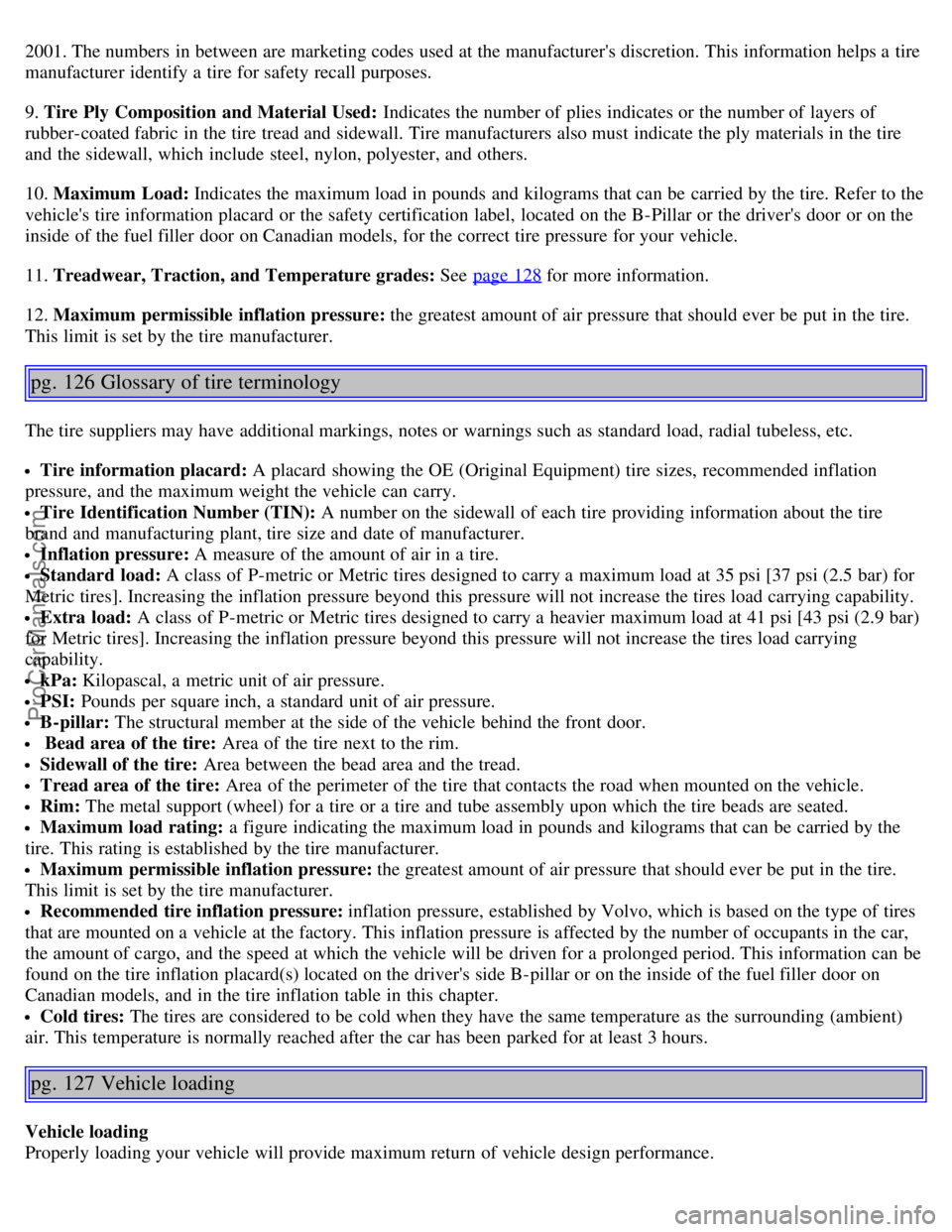
2001. The numbers in between are marketing codes used at the manufacturer's discretion. This information helps a tire
manufacturer identify a tire for safety recall purposes.
9. Tire Ply Composition and Material Used: Indicates the number of plies indicates or the number of layers of
rubber-coated fabric in the tire tread and sidewall. Tire manufacturers also must indicate the ply materials in the tire
and the sidewall, which include steel, nylon, polyester, and others.
10. Maximum Load: Indicates the maximum load in pounds and kilograms that can be carried by the tire. Refer to the
vehicle's tire information placard or the safety certification label, located on the B-Pillar or the driver's door or on the
inside of the fuel filler door on Canadian models, for the correct tire pressure for your vehicle.
11. Treadwear, Traction, and Temperature grades: See page 128
for more information.
12. Maximum permissible inflation pressure: the greatest amount of air pressure that should ever be put in the tire.
This limit is set by the tire manufacturer.
pg. 126 Glossary of tire terminology
The tire suppliers may have additional markings, notes or warnings such as standard load, radial tubeless, etc.
Tire information placard: A placard showing the OE (Original Equipment) tire sizes, recommended inflation
pressure, and the maximum weight the vehicle can carry.
Tire Identification Number (TIN): A number on the sidewall of each tire providing information about the tire
brand and manufacturing plant, tire size and date of manufacturer.
Inflation pressure: A measure of the amount of air in a tire.
Standard load: A class of P-metric or Metric tires designed to carry a maximum load at 35 psi [37 psi (2.5 bar) for
Metric tires]. Increasing the inflation pressure beyond this pressure will not increase the tires load carrying capability.
Extra load: A class of P-metric or Metric tires designed to carry a heavier maximum load at 41 psi [43 psi (2.9 bar)
for Metric tires]. Increasing the inflation pressure beyond this pressure will not increase the tires load carrying
capability.
kPa: Kilopascal, a metric unit of air pressure.
PSI: Pounds per square inch, a standard unit of air pressure.
B-pillar: The structural member at the side of the vehicle behind the front door.
Bead area of the tire: Area of the tire next to the rim.
Sidewall of the tire: Area between the bead area and the tread.
Tread area of the tire: Area of the perimeter of the tire that contacts the road when mounted on the vehicle.
Rim: The metal support (wheel) for a tire or a tire and tube assembly upon which the tire beads are seated.
Maximum load rating: a figure indicating the maximum load in pounds and kilograms that can be carried by the
tire. This rating is established by the tire manufacturer.
Maximum permissible inflation pressure: the greatest amount of air pressure that should ever be put in the tire.
This limit is set by the tire manufacturer.
Recommended tire inflation pressure: inflation pressure, established by Volvo, which is based on the type of tires
that are mounted on a vehicle at the factory. This inflation pressure is affected by the number of occupants in the car,
the amount of cargo, and the speed at which the vehicle will be driven for a prolonged period. This information can be
found on the tire inflation placard(s) located on the driver's side B-pillar or on the inside of the fuel filler door on
Canadian models, and in the tire inflation table in this chapter.
Cold tires: The tires are considered to be cold when they have the same temperature as the surrounding (ambient)
air. This temperature is normally reached after the car has been parked for at least 3 hours.
pg. 127 Vehicle loading
Vehicle loading
Properly loading your vehicle will provide maximum return of vehicle design performance.
ProCarManuals.com
Page 81 of 127
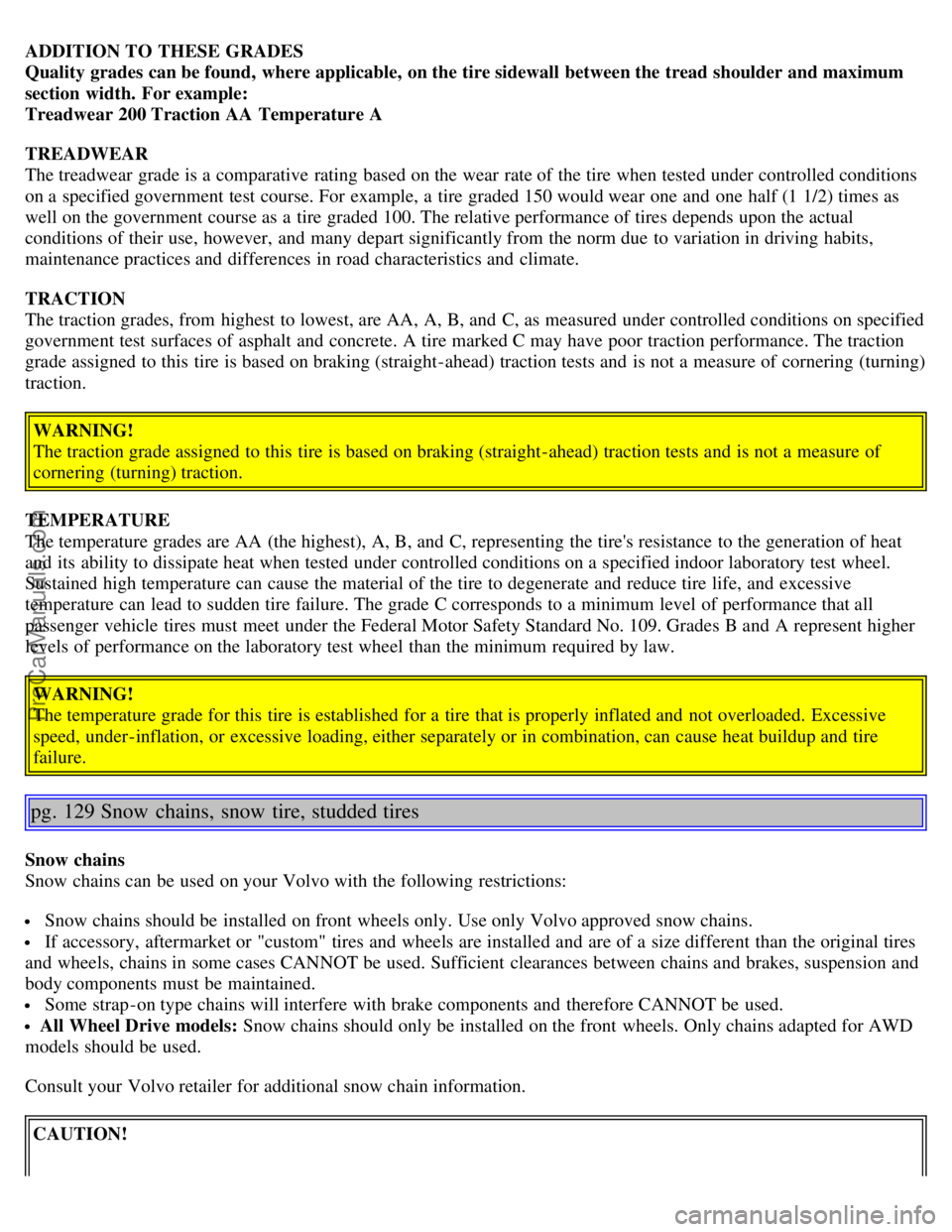
ADDITION TO THESE GRADES
Quality grades can be found, where applicable, on the tire sidewall between the tread shoulder and maximum
section width. For example:
Treadwear 200 Traction AA Temperature A
TREADWEAR
The treadwear grade is a comparative rating based on the wear rate of the tire when tested under controlled conditions
on a specified government test course. For example, a tire graded 150 would wear one and one half (1 1/2) times as
well on the government course as a tire graded 100. The relative performance of tires depends upon the actual
conditions of their use, however, and many depart significantly from the norm due to variation in driving habits,
maintenance practices and differences in road characteristics and climate.
TRACTION
The traction grades, from highest to lowest, are AA, A, B, and C, as measured under controlled conditions on specified
government test surfaces of asphalt and concrete. A tire marked C may have poor traction performance. The traction
grade assigned to this tire is based on braking (straight-ahead) traction tests and is not a measure of cornering (turning)
traction.WARNING!
The traction grade assigned to this tire is based on braking (straight-ahead) traction tests and is not a measure of
cornering (turning) traction.
TEMPERATURE
The temperature grades are AA (the highest), A, B, and C, representing the tire's resistance to the generation of heat
and its ability to dissipate heat when tested under controlled conditions on a specified indoor laboratory test wheel.
Sustained high temperature can cause the material of the tire to degenerate and reduce tire life, and excessive
temperature can lead to sudden tire failure. The grade C corresponds to a minimum level of performance that all
passenger vehicle tires must meet under the Federal Motor Safety Standard No. 109. Grades B and A represent higher
levels of performance on the laboratory test wheel than the minimum required by law. WARNING!
The temperature grade for this tire is established for a tire that is properly inflated and not overloaded. Excessive
speed, under-inflation, or excessive loading, either separately or in combination, can cause heat buildup and tire
failure.
pg. 129 Snow chains, snow tire, studded tires
Snow chains
Snow chains can be used on your Volvo with the following restrictions:
Snow chains should be installed on front wheels only. Use only Volvo approved snow chains.
If accessory, aftermarket or "custom" tires and wheels are installed and are of a size different than the original tires
and wheels, chains in some cases CANNOT be used. Sufficient clearances between chains and brakes, suspension and
body components must be maintained.
Some strap -on type chains will interfere with brake components and therefore CANNOT be used.
All Wheel Drive models: Snow chains should only be installed on the front wheels. Only chains adapted for AWD
models should be used.
Consult your Volvo retailer for additional snow chain information.
CAUTION!
ProCarManuals.com
Page 84 of 127
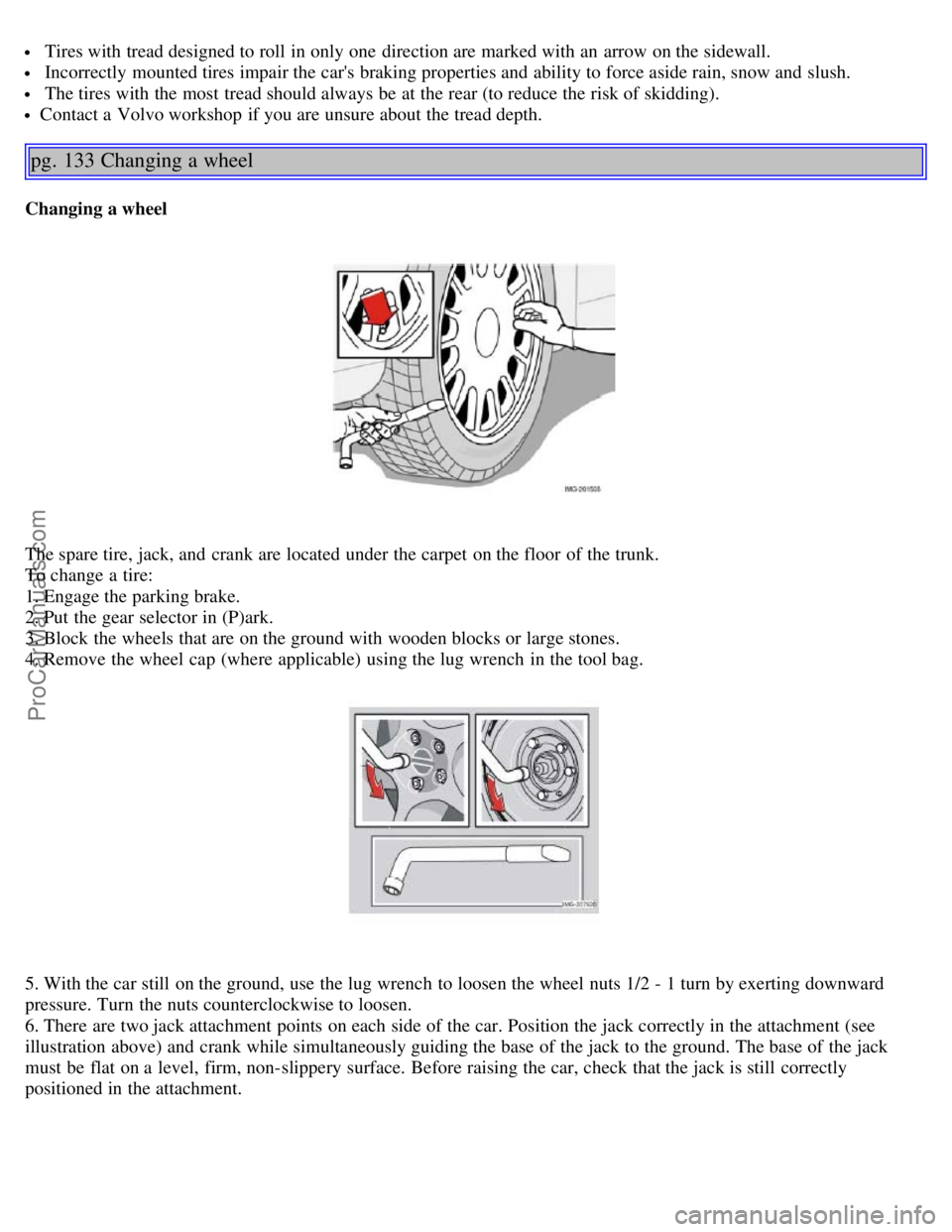
Tires with tread designed to roll in only one direction are marked with an arrow on the sidewall.
Incorrectly mounted tires impair the car's braking properties and ability to force aside rain, snow and slush.
The tires with the most tread should always be at the rear (to reduce the risk of skidding).
Contact a Volvo workshop if you are unsure about the tread depth.
pg. 133 Changing a wheel
Changing a wheel
The spare tire, jack, and crank are located under the carpet on the floor of the trunk.
To change a tire:
1. Engage the parking brake.
2. Put the gear selector in (P)ark.
3. Block the wheels that are on the ground with wooden blocks or large stones.
4. Remove the wheel cap (where applicable) using the lug wrench in the tool bag.
5. With the car still on the ground, use the lug wrench to loosen the wheel nuts 1/2 - 1 turn by exerting downward
pressure. Turn the nuts counterclockwise to loosen.
6. There are two jack attachment points on each side of the car. Position the jack correctly in the attachment (see
illustration above) and crank while simultaneously guiding the base of the jack to the ground. The base of the jack
must be flat on a level, firm, non-slippery surface. Before raising the car, check that the jack is still correctly
positioned in the attachment.
ProCarManuals.com
Page 123 of 127
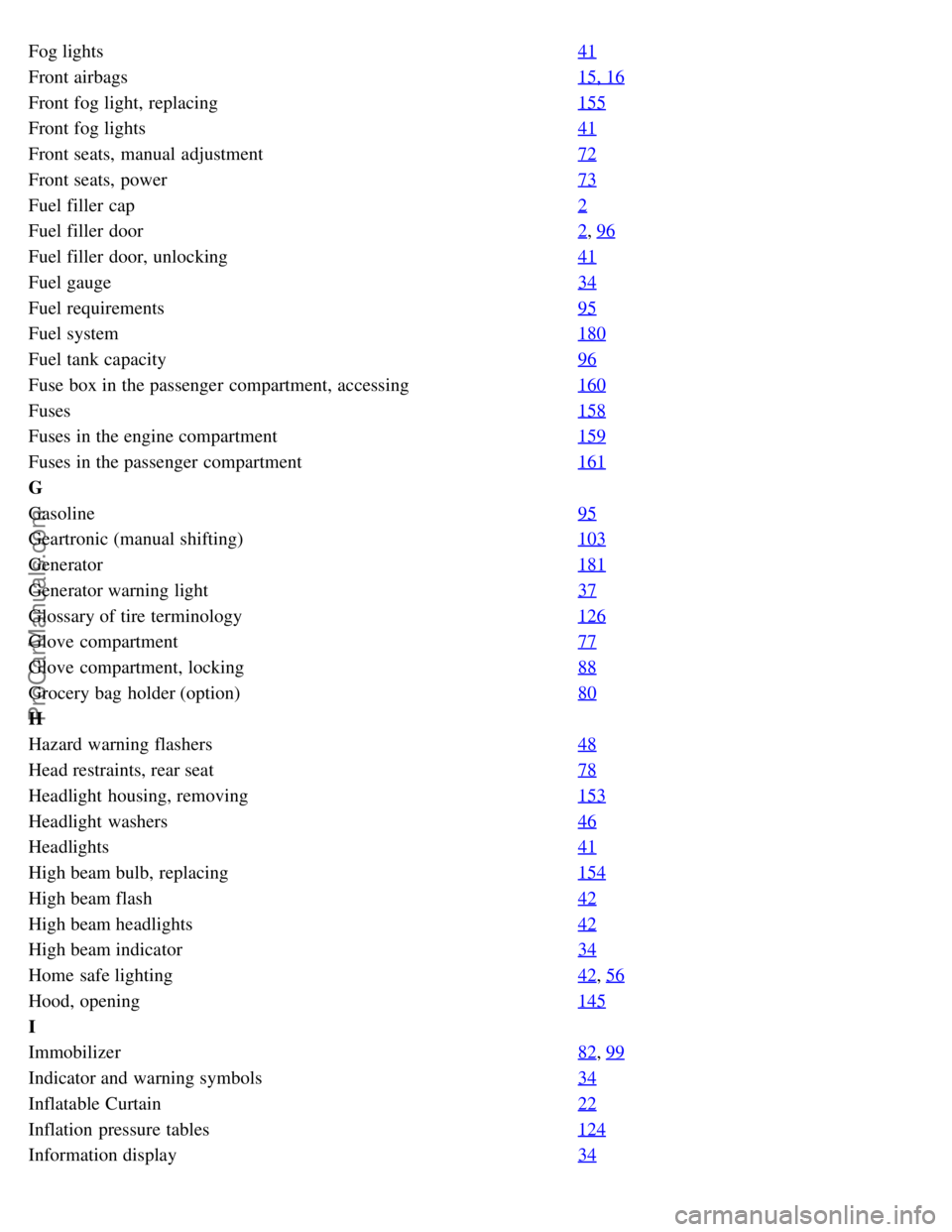
Fog lights41
Front airbags15, 16
Front fog light, replacing155
Front fog lights41
Front seats, manual adjustment72
Front seats, power73
Fuel filler cap2
Fuel filler door2, 96
Fuel filler door, unlocking41
Fuel gauge34
Fuel requirements95
Fuel system180
Fuel tank capacity96
Fuse box in the passenger compartment, accessing160
Fuses158
Fuses in the engine compartment159
Fuses in the passenger compartment161
G
Gasoline95
Geartronic (manual shifting)103
Generator181
Generator warning light37
Glossary of tire terminology126
Glove compartment77
Glove compartment, locking88
Grocery bag holder (option)80
H
Hazard warning flashers48
Head restraints, rear seat78
Headlight housing, removing153
Headlight washers46
Headlights41
High beam bulb, replacing154
High beam flash42
High beam headlights42
High beam indicator34
Home safe lighting42, 56
Hood, opening145
I
Immobilizer82
, 99
Indicator and warning symbols34
Inflatable Curtain22
Inflation pressure tables124
Information display34
ProCarManuals.com
Page 126 of 127
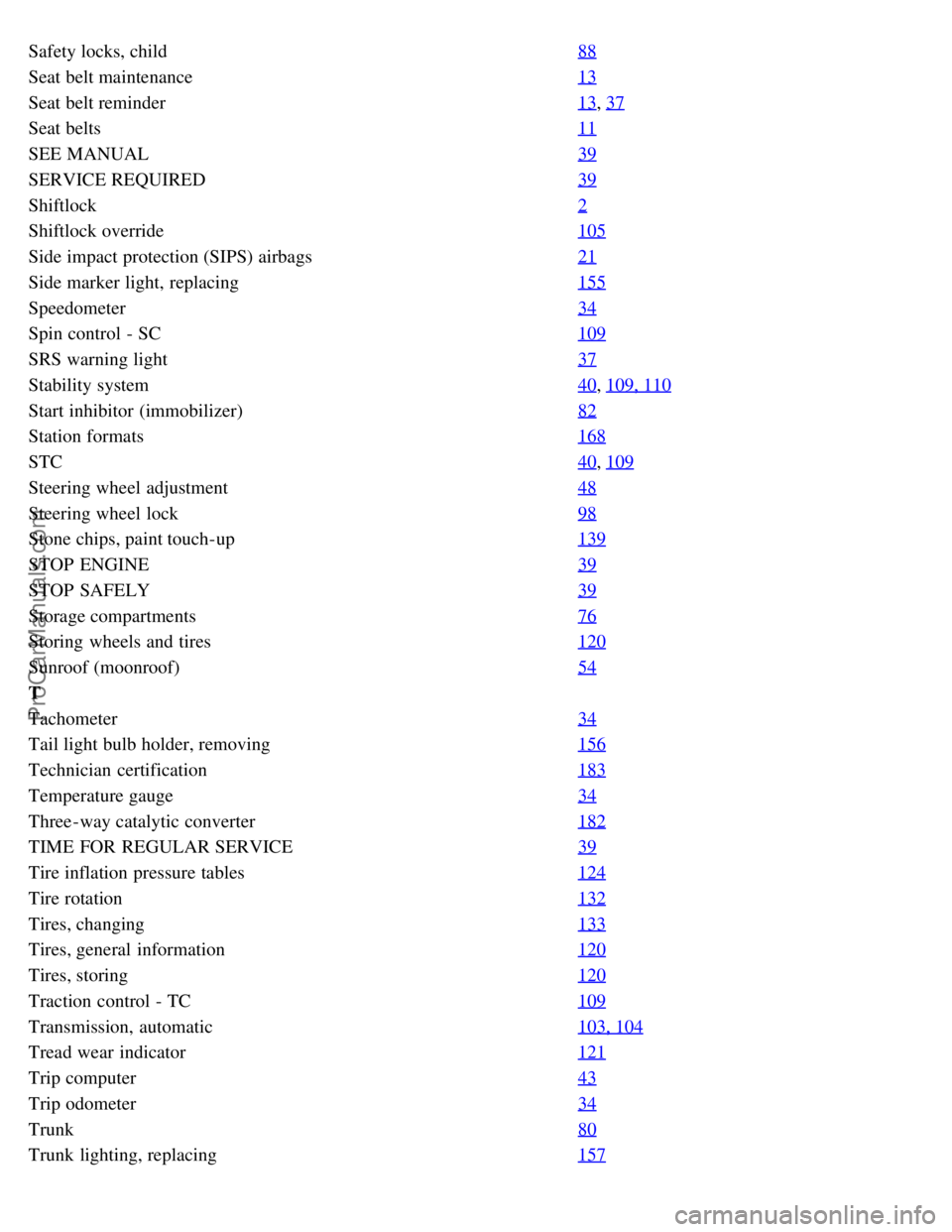
Safety locks, child88
Seat belt maintenance13
Seat belt reminder13, 37
Seat belts11
SEE MANUAL39
SERVICE REQUIRED39
Shiftlock2
Shiftlock override105
Side impact protection (SIPS) airbags21
Side marker light, replacing155
Speedometer34
Spin control - SC109
SRS warning light37
Stability system40, 109, 110
Start inhibitor (immobilizer)82
Station formats168
STC40, 109
Steering wheel adjustment48
Steering wheel lock98
Stone chips, paint touch-up139
STOP ENGINE39
STOP SAFELY39
Storage compartments76
Storing wheels and tires120
Sunroof (moonroof)54
T
Tachometer34
Tail light bulb holder, removing156
Technician certification183
Temperature gauge34
Three-way catalytic converter182
TIME FOR REGULAR SERVICE39
Tire inflation pressure tables124
Tire rotation132
Tires, changing133
Tires, general information120
Tires, storing120
Traction control - TC109
Transmission, automatic103, 104
Tread wear indicator121
Trip computer43
Trip odometer34
Trunk80
Trunk lighting, replacing157
ProCarManuals.com
Page 127 of 127
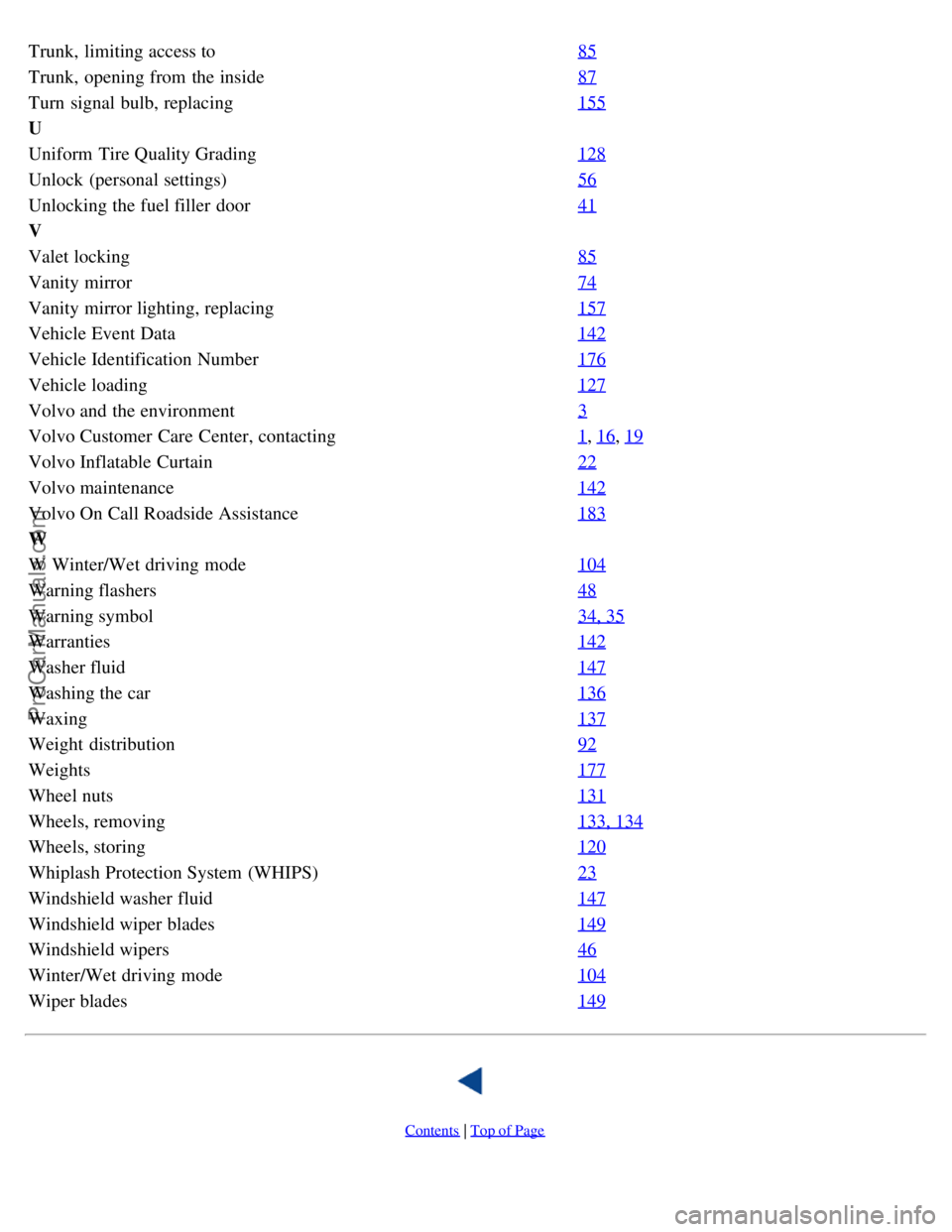
Trunk, limiting access to85
Trunk, opening from the inside87
Turn signal bulb, replacing155
U
Uniform Tire Quality Grading128
Unlock (personal settings)56
Unlocking the fuel filler door41
V
Valet locking85
Vanity mirror74
Vanity mirror lighting, replacing157
Vehicle Event Data142
Vehicle Identification Number176
Vehicle loading127
Volvo and the environment3
Volvo Customer Care Center, contacting1, 16, 19
Volvo Inflatable Curtain22
Volvo maintenance142
Volvo On Call Roadside Assistance183
W
W Winter/Wet driving mode104
Warning flashers48
Warning symbol34, 35
Warranties142
Washer fluid147
Washing the car136
Waxing137
Weight distribution92
Weights177
Wheel nuts131
Wheels, removing133, 134
Wheels, storing120
Whiplash Protection System (WHIPS)23
Windshield washer fluid147
Windshield wiper blades149
Windshield wipers46
Winter/Wet driving mode104
Wiper blades149
Contents | Top of Page
ProCarManuals.com